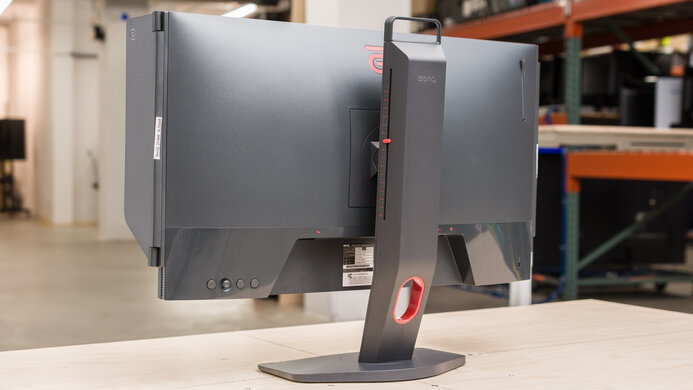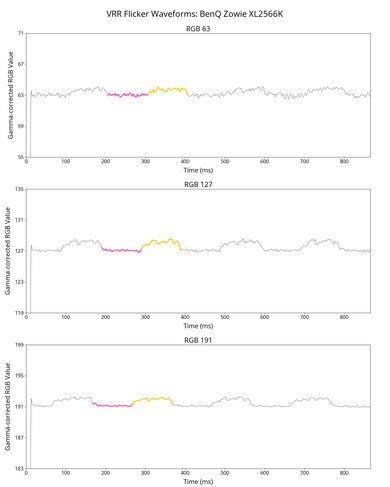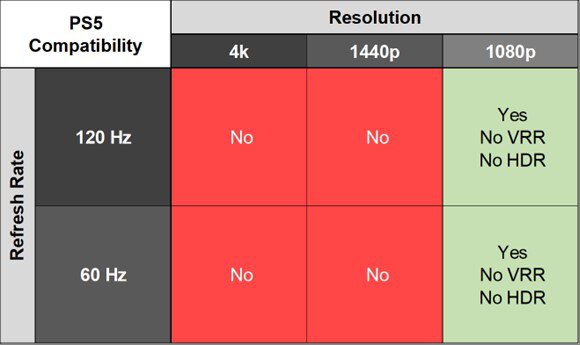The BenQ ZOWIE XL2566K is the flagship model in BenQ's ZOWIE lineup of gaming monitors, sitting above the BenQ ZOWIE XL2546K. It uses a TN panel designed to deliver the best gaming experience possible, and it's one of the only monitors on the market that offers a customizable overdrive setting, meaning you can fine-tune the gaming experience to your preferences. It comes with a unique S-Switch wired remote that makes it a breeze to navigate the settings menu, as well as side panels to keep you focused on the game.
Our Verdict
The BenQ ZOWIE XL2566K is passable for PC gaming. It's mainly designed for esports gamers as it has a high 360Hz refresh rate, low input lag, and impressive motion handling across its entire VRR range, so motion looks sharp no matter the refresh rate you're gaming at. It supports FreeSync and is G-SYNC compatible, and there isn't too much distracting VRR flicker with changing frame rates. Unfortunately, it's disappointing if you care about having good picture quality while gaming, as it has a low contrast ratio, and it doesn't support HDR at all.
- Incredible motion handling with very little motion blur.
- Superb low input lag.
- Versatile backlight strobing feature.
- Mediocre contrast ratio.
- No HDR support.
The BenQ ZOWIE XL2566K is poor for console gaming. It has limited compatibility with both the PS5 and Xbox Series X|S as it doesn't even support HDR, but its picture quality is limited regardless. It has a 1080p resolution, so it can't deliver detailed images while gaming. That said, it has low enough input lag for a responsive feel, and it has a fast response time for sharp motion.
- Incredible motion handling with very little motion blur.
- Superb low input lag.
- Mediocre contrast ratio.
- No HDR support.
- Limited console compatibility.
The BenQ ZOWIE XL2566K is unremarkable for office use. It has good peak brightness in SDR and good reflection handling, so it can easily overcome glare in a bright office. It also has impressive ergonomics, so you can easily place it in an ideal viewing position. On the other hand, it has a relatively low pixel density, so text clarity is just decent, and the image rapidly degrades when viewed at an angle, so anyone looking at your screen beside you will see a worse image.
- Impressive ergonomics.
- Good peak brightness in SDR.
- Image degrades rapidly when viewed at an angle.
- Low pixel density.
The BenQ ZOWIE XL2566K is disappointing for media creation. It has impressive ergonomics, so you can easily place it in an ideal viewing position or turn it to show something to your clients or colleagues. It also has impressive color accuracy and displays a wide range of colors in SDR, but it doesn't support HDR at all. Unfortunately, it has a low contrast ratio, so it performs poorly in a dark room, and the image degrades rapidly when viewed from an angle.
- Impressive ergonomics.
- Excellent accuracy before calibration.
- Good peak brightness in SDR.
- Mediocre contrast ratio.
- Image degrades rapidly when viewed at an angle.
- Low pixel density.
- No HDR support.
The BenQ ZOWIE XL2566K has good brightness in SDR, enough to fight glare, but it doesn't support HDR at all.
- Good peak brightness in SDR.
- No HDR support.
The BenQ ZOWIE XL2566K has an impressive response time. It maintains a fast response time across its VRR range, leading to sharp motion. It also has impressive refresh rate compliance, meaning its response time is fast enough to keep up with 120 fps and 60 fps sources.
- Maintains fast response time across VRR range.
- Impressive refresh rate compliance.
The BenQ ZOWIE XL2566K doesn't support HDR.
The BenQ ZOWIE XL2566K has okay SDR picture quality. Its main weakness is that it has a low contrast ratio, so blacks look gray next to bright highlights, and there's also blooming around bright objects.
- Excellent accuracy before calibration.
- Mediocre contrast ratio.
The BenQ ZOWIE XL2566K has impressive color accuracy. Although it doesn't have a dedicated sRGB color gamut, it still limits colors well to the sRGB color space without oversaturating them. That said, calibrating it still results in the best accuracy. Unfortunately, it fails to maintain these accurate colors across the entire screen as it has uniformity issues.
- Excellent accuracy before calibration.
- Uniformity issues.
Performance Usages
Changelog
- Updated Feb 21, 2025: We've converted this review to Test Bench 2.0.1. This includes a new test result for DisplayPort 2.1 Transmission Bandwidth.
- Updated Apr 19, 2024: Corrected the main pursuit photo for Backlight Strobing (BFI) as it's better than the previous photo.
- Updated Apr 17, 2024: Updated text throughout the review according to Test Bench 2.0, mainly in the Verdict and Motion sections.
- Updated Apr 17, 2024: We've converted this review to Test Bench 2.0. This includes new tests for VRR Motion Performance, Refresh Rate Compliance, Cumulative Absolute Deviation (CAD), and VRR Flicker. You can read the full changelog here.
Check Price
Differences Between Sizes And Variants
We tested the 24.5-inch BenQ ZOWIE XL2566K, which is part of BenQ's XL-K series of gaming monitors, some of which are listed below. These results are only valid for this specific model, though.
| Model Code | Size | Resolution | Max Refresh Rate | DyAc+ |
| XL2566K | 24.5" | 1080p | 360Hz | Yes |
| XL2546K | 24.5" | 1080p | 240Hz | Yes |
| XL2540K | 24.5" | 1080p | 240Hz | No |
| XL2746K | 27" | 1080p | 240Hz | Yes |
Our unit was manufactured in September 2022, and you can see the label here.
Popular Monitor Comparisons
The BenQ ZOWIE XL2566K is an okay PC gaming monitor, but with impressive motion handling across its VRR range and low input lag, it's an excellent choice for esports gamers. Unfortunately, its TN-type panel delivers lackluster overall picture quality, and it lacks many features found on most recent gaming monitors, like HDR support or local dimming. It's only recommended if you only care about motion performance.
Also see our recommendations for the best budget and cheap gaming monitors, the best 1080p monitors, and the best gaming monitors.
The BenQ ZOWIE XL2546X and the BenQ ZOWIE XL2566K are very similar 25-inch monitors. They're well-suited to esports gamers who only care about good motion handling. However, the XL2566K is the better choice, as fast-moving objects look slightly sharper on its display, and it's far more responsive at 60Hz. That said, the image quality on both monitors isn't very good, and you should consider other monitors we recommend in our best gaming monitors article if you care about a good image.
The BenQ ZOWIE XL2566K and the BenQ ZOWIE XL2586X are similar esports gaming monitors. They each have a TN panel, and while the XL2586X has a higher refresh rate, the XL2566K has more consistent motion handling over its VRR range. However, the XL2586X is the better choice if you have an HDMI 2.1 graphics card because it supports HDMI 2.1 bandwidth.
The Dell Alienware AW2523HF and the BenQ ZOWIE XL2566K deliver a very similar experience. The Dell has a much better viewing angle, delivering a more consistent visual experience when viewed at an angle. The Dell gets brighter in SDR to overcome more glare in a bright room. The BenQ has a more customizable gaming experience and more consistent motion handling than the Dell, especially at lower refresh rates.
The ASUS ROG Swift 360Hz PG259QN is a much better monitor overall than the BenQ ZOWIE XL2566K, but the BenQ is still a good choice for gamers. The ASUS delivers much better picture quality, with a wider viewing angle, HDR support, and better gradient handling. On the other hand, the BenQ delivers better motion handling, with less overshoot and a faster response time, so it's a slightly better choice for esports gamers who prefer motion handling over picture quality.

We buy and test more than 30 monitors each year, with units that we buy completely on our own, without any cherry-picked units or samples. We put a lot into each unbiased, straight-to-the-point review, and there's a whole process from purchasing to publishing, involving multiple teams and people. We do more than just use the monitor for a week; we use specialized and custom tools to measure various aspects with objective data-based results. We also consider multiple factors before making any recommendations, including the monitor's cost, its performance against the competition, and whether or not it's easy to find.
Test Results

The BenQ ZOWIE XL2566K has a simple design with a definite gamer aesthetic. The bezels are roughly the same thickness on all four sides, which looks nice, but they're thicker and deeper than more premium models. There are two adjustable shields on either side of the monitor to keep you focused on your game. It has a few nice convenience features, including a built-in headphone hook to keep your desk organized when you're not gaming.
The build quality is just okay. It's made entirely of plastic, and it feels a bit cheap. The plastic panels have little flex to them, which is good, and it doesn't seem likely to break. The bezels aren't properly attached to the screen, though, and on our unit, it's easy to lift them off the screen.
The BenQ ZOWIE XL2566K has impressive ergonomics, so you can easily and quickly adjust it to an ideal viewing position. The height adjustment even has a ruler, so you can quickly adjust it to the perfect height depending on your needs. There's a hole in the stand for cable management.
The stand is simple, with a small, flat base, so you can easily place things in front of it or stash your keyboard when you're not gaming. The height adjustment is on an angle, so the total thickness varies depending on the height you set. The posted measurements are at the thickest position.
There's a joystick on the back of the monitor for navigating the monitor's on-screen display and two preset buttons on the back. There's also an external S-Switch controller that makes it even easier to navigate the menus and change settings on the fly.
- Power cable
- HDMI cable
- DisplayPort cable
- S-Switch
- Monitor cover (shown here)
- User documentation and guides
Unfortunately, this monitor doesn't have a local dimming feature. We still film this video on the monitor so you can compare the backlight performance to another monitor with local dimming.
The BenQ ZOWIE XL2566K has good peak brightness in SDR. It's bright enough to overcome glare, and there's very little variation in peak brightness with different scenes. The minimum brightness is a bit high, so it's not ideal for users looking to use it in a completely dark room.
These measurements are taken after calibration, in the 'Standard' Picture Mode, with the Brightness at max.
This monitor doesn't support HDR.
Unfortunately, the horizontal viewing angle is just passable. Colors shift rapidly as you move off-center and appear noticeably washed out at a moderate angle, so it's not ideal for sharing your screen with someone sitting beside you.
Unfortunately, like all monitors with a TN panel, the vertical viewing angle is poor. Looking at it from above, the image fades and appears washed out, but looking at it from below, the image is completely inversed and looks bad.
The BenQ ZOWIE XL2566K has excellent accuracy before calibration. The white balance is excellent, with no noticeable issues, and most colors are displayed properly. Pure blues are a bit off, but it's not noticeable. Colors aren't oversaturated, and it covers most of the sRGB gamut area without needing a dedicated sRGB mode. Gamma tracks the sRGB target curve nearly perfectly.
The color accuracy and white balance are superb after calibration, but it doesn't make a noticeable difference on this monitor, as it was already excellent.
The SDR color gamut is excellent. It displays most of the sRGB color space used by most desktop and web content. Sadly, it can't display any of the wider range of colors supported by the Adobe RGB color space, so it's not suited for print or photo processing using this color space.
This monitor doesn't support HDR.
This monitor doesn't support HDR.
The maximum refresh rate of this monitor is only supported over DisplayPort due to the bandwidth limitations of the HDMI port on this monitor.
| NVIDIA | VRR Min | VRR Max |
| DisplayPort | <20Hz | 360Hz |
| HDMI | N/A | N/A |
| AMD | VRR Min | VRR Max |
| DisplayPort | <20Hz | 360Hz |
| HDMI | <20Hz | 240Hz |
Although not officially certified for either AMD FreeSync or NVIDIA G-SYNC variable refresh rates, there aren't any issues with either.
| Refresh Rate | CAD Heatmap | RT Chart | Pursuit Photo |
| 358 | Heatmap | Chart | Photo |
| 240 | Heatmap | Chart | Photo |
| 165 | Heatmap | Chart | Photo |
| 144 | Heatmap | Chart | Photo |
| 120 | Heatmap | Chart | Photo |
| 100 | Heatmap | Chart | Photo |
| 80 | Heatmap | Chart | Photo |
| 60 | Heatmap | Chart | Photo |
The BenQ XL2566K has impressive motion handling across its entire refresh rate range with VRR enabled. It has a few different overdrive settings, which is called AMA, including a 'Custom' setting that has a slider. Setting it to '8' results in the most consistent performance across the entire refresh rate range, but 'High' and 'Premium' are good choices if your games maintain high frame rates.
The refresh rate compliance is impressive. The 'Custom 8' and 'High' overdrive settings perform similarly, but the response time isn't fast enough to take advantage of the monitor's high refresh rate. That said, it's much better at lower refresh rates.
| Overdrive Mode | CAD Heatmap | RT Chart | Pursuit Photo |
| Off | Heatmap | Chart | Photo |
| Custom 8 | Heatmap | Chart | Photo |
| High | Heatmap | Chart | Photo |
| Premium | Heatmap | Chart | Photo |
The CAD at the max refresh rate of 360Hz is excellent. If you play competitive games that maintain such a high frame rate, the 'Premium' overdrive setting performs the best. That said, it has some inverse ghosting, so it's better to use 'High' if that bothers you, but it has a bit more motion blur.
| Overdrive Mode | CAD Heatmap | RT Chart | Pursuit Photo |
| Off | Heatmap | Chart | Photo |
| Custom 8 | Heatmap | Chart | Photo |
| High | Heatmap | Chart | Photo |
| Premium | Heatmap | Chart | Photo |
The CAD at 120Hz is great, but there's some smearing. The 'Custom 8' and 'Premium' settings perform similarly with the same CAD, but this only happens if you set the monitor's max refresh rate to 120Hz. If you set it to a higher refresh rate and use VRR while the frame rate goes down to 120 fps, then the 'Custom 8' overdrive setting is better, as explained in VRR Motion Performance. 'High' also performs well, but 'Off' is the worst performing overdrive setting.
| Overdrive Mode | CAD Heatmap | RT Chart | Pursuit Photo |
| Off | Heatmap | Chart | Photo |
| Custom 8 | Heatmap | Chart | Photo |
| High | Heatmap | Chart | Photo |
| Premium | Heatmap | Chart | Photo |
The CAD at 60Hz is great, despite some smearing. The 'Custom 8', 'High', and 'Premium' overdrive settings all have the same CAD, but because 'Premium' is the recommended setting at higher refresh rates, it's a good set-and-forget mode if you change games. However, the motion handling is different if you set the monitor's refresh rate to 60Hz versus setting it to a higher refresh rate and using VRR as the frame rate goes down to 60 fps. In that case, the 'Custom 8' overdrive setting is better, as explained in VRR Motion Performance.
| Refresh Rate | BFI Setting 60Hz | Motion Blur Photo |
| 60Hz | Premium | Photo |
| High | Photo | |
| 120Hz | Premium | Photo |
| High | Photo | |
| 360Hz | Premium | Photo |
| High | Photo |
The BenQ ZOWIE XL2566K has a versatile backlight strobing feature, which BenQ calls DyAC+, to improve the appearance of motion. It's available across a wide range of refresh rates, nearly the full range of the monitor itself, but it doesn't work at the same time as VRR. Sadly, although you can enable it as low as 60Hz, it still flickers at 120Hz, creating image duplication.
Thanks to its fast refresh rate, there's very little input lag when gaming, ensuring a responsive gaming experience. The input lag is noticeably higher at 60Hz, even higher than most other monitors at 60Hz, but it's not too bad.
Sadly, the low resolution of this screen results in a very low pixel density, so text and images aren't very sharp.
There's a mini-USB port on the back of the monitor, but it's only for the S-Switch remote.
This is a pretty barebones monitor with no significant additional features. There are a few picture mode modifiers like Black eQualizer, which adjusts the gamma to make it easier to spot dark details, and a blue light filter. It also comes with the S-Switch remote, making it very easy to navigate the on-screen display or switch between preset modes.






























































